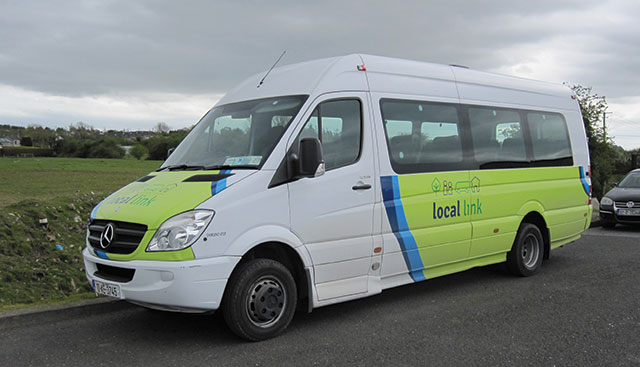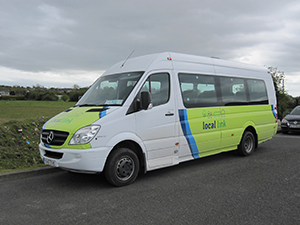Sustaining rural communities

The General Manager of Local Link Kerry, Carmel Walsh highlights the importance of community transport in Ireland.
Transport is a prerequisite for sustainable rural communities. With an increasingly ageing and rural dwelling population the General Manager of Local Link Kerry is adamant there is a need for a robust network of community transport throughout Ireland. The rural transport programme was developed 14 years ago and was focused on delivering social inclusion, removing the barriers to participation and access to a wide range of community services and facilities, shopping and healthcare.
 In 2002 Kerry Community Transport [now Local Link Kerry] was established to respond to the unresolved transport needs across the county. It was originally funded by the Department of Public Enterprise as one of seven rural transport initiatives and has grown to provide 125 weekly services, all of which are delivered by contracted private operators.
In 2002 Kerry Community Transport [now Local Link Kerry] was established to respond to the unresolved transport needs across the county. It was originally funded by the Department of Public Enterprise as one of seven rural transport initiatives and has grown to provide 125 weekly services, all of which are delivered by contracted private operators.
Local Link Kerry (LLK) operates a county-wide call centre responsible for trasnport coordination. LLK works with local communities to develop transport services which respond to unmet needs.
In 2015, 131,389 passenger trips were facilitated and over 500,000 km were covered by contracted private operators. It is not just those who avail of the transport that benefit from the programme as in 2015, LLK trained over 150 drivers and passenger assistants in driver, accessibility and minibus evacuation training.
“The rural transport programme promotes connectivity and access to a wide range of vital community services, GP, shopping, day centre, employment, and education. It encourages social inclusion and interaction. We know that people have a better quality of life if they can continue to live independently in their own home and still have access to vital community services,” states Walsh.
The development of the rural transport programme is supported by community organisations, who identified huge gaps in provision that existed throughout the county. “In the beginning we provided routes where there were none,” states Walsh. “Initially the services were limited in most areas, ran one day a week and even now gaps still exist.”
In 2015, 50 per cent of services were provided by wheelchair accessible vehicles and 4,057 passenger trips were made by wheelchair users. “The service is really appreciated by local residents of all ages and this is highlighted in the diverse age range of our users,” states Walsh. Last year, 71 per cent of the services passengers were over the age of 66, 11 per cent were between 26 and 65 and 18 per cent were under 26.
National approach
Initially financed by the Department of Public Enterprise the rural transport programme was rolled out nationwide in 2007 with the principal aim of providing a quality, community based public transport system that responds to local needs. Following a value for money review in 2011, the rural transport programme was restructured and in 2012 the National Transport Authority (NTA) took control of its management.
At present there are 17 Transport Coordination Units (TCUs), 400 operators and 900 drivers across Ireland. The service has proved popular across the country with 1.76 million passenger journeys recorded in 2015. “Since the NTA took over the management of the programme, frameworks have changed in relation to tendering and procurement and we now have a national brand but the NTA hasn’t come in and said this is the right or wrong way to operate,” states Walsh. “It has supported the development of conventional and unconventional delivery models and is focused on integrating the services with other community provisions. Overall we have found working with the NTA to be very positive in regards to the delivery and management of services in the county.”
 The benefits of having the NTA manage the programme have been numerous. With the NTA now the programme managers, both rural transport providers and their mainstream counterparts are integrated. “All contracts are now nationally procured and owned by the NTA,” says Walsh. “Going forward operators will have five year contracts with the NTA and this creates the opportunity to assess other factors such as accessibility. When we first started this programme, community transport in Ireland was synonymous with the transit van, but really it is just a van with windows. Over the past 14 years operators have come a long way in relation to fleet, now, we can encourage our operators to think differently and think about end user needs. There is an opportunity to look at the fleet in relation to accessibility and energy efficient vehicles.
The benefits of having the NTA manage the programme have been numerous. With the NTA now the programme managers, both rural transport providers and their mainstream counterparts are integrated. “All contracts are now nationally procured and owned by the NTA,” says Walsh. “Going forward operators will have five year contracts with the NTA and this creates the opportunity to assess other factors such as accessibility. When we first started this programme, community transport in Ireland was synonymous with the transit van, but really it is just a van with windows. Over the past 14 years operators have come a long way in relation to fleet, now, we can encourage our operators to think differently and think about end user needs. There is an opportunity to look at the fleet in relation to accessibility and energy efficient vehicles.
“As people get older their mobility can be a challenge. While they may not be confined to a wheelchair, a vehicle equipped with a wheelchair lift could still be beneficial for them and their access to the vehicle. This is why we are now including the TCUs in the journey planner and there is great excitement about what we will be able to deliver in this area.”
The Transport Coordination Units are responsible for the management of day-to-day requests for and the delivery of public transport services. They are also tasked with reporting on transport services as well as managing voluntary community schemes and local community transport needs in socially disadvantaged areas. “The TCUs support the development of community and public transport services and coordinate services on behalf of other organisations,” explains Walsh. “They have considerable contracts in the management of HSE services and are focused on integrating these into community transport provisions in line with the national integration objectives.”
The development of a strategic plan for TCUs nationally will enhance their huge potential to co-ordinate the further development and integration of transportation at county level. The TCUs will work with local authorities who have responsibility for the development of county transportation plans.
There is currently a huge level of exchequer investment in a range of transport in every county. To support efficiencies and environmental objectives the TCUs are best placed to coordinate integration by joined up thinking and reinvesting savings back into sustaining public transport in rural Ireland.
Looking ahead, Walsh notes how the organisation’s key priorities are for the retendering of all services, to implement the new IT system in its entirety, to identify further transport needs and to increase the frequency of provision. “From this programme’s humble beginnings there have been a lot of ups and downs but now it is about building on the service and with the strong support of the local communities and volunteers, the future of local community transport in Ireland looks bright,” she concludes.





